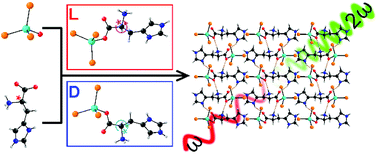Novel noncentrosymmetric polar coordination compounds derived from chiral histidine ligands†
Abstract
Crystals of chiral coordination compounds, [L-C6H10N3O2ZnBr3] (L-ZnBr), [D-C6H10N3O2ZnBr3] (D-ZnBr), [L-C12H20N6O4Cd2Cl5] (L-CdCl), and [D-C12H20N6O4Cd2Cl5] (D-CdCl), have been grown in high yields by using MX2 (M = Zn or Cd; X = Br or Cl) and L- or D-histidine by a slow evaporation method in acidic media. Single crystal X-ray diffraction reveals that while the structures of L-ZnBr and D-ZnBr crystallizing in the polar space group, P21, consist of slightly distorted ZnOBr3 tetrahedra and the respective chiral histidine ligands, those of L-CdCl and D-CdCl with the triclinic noncentrosymmetric (NCS) space group, P1, are composed of distorted CdOCl4 trigonal bipyramids and the corresponding histidine ligands. Whereas the structures of L-ZnBr and D-ZnBr can be extended to pseudo-1D chains via hydrogen bonds, those of L-CdCl and D-CdCl can be assembled to pseudo-3D frameworks through hydrogen bonds and π–π interactions. UV-vis diffuse reflectance spectra suggest that the title compounds have large optical band gaps of ca. 5 eV. The powder second-harmonic generation (SHG) measurements indicate that the new materials with NCS structures have mild SHG efficiencies of ca. 0.2 times that of KH2PO4, and type-I phase-matching behaviors. Circular dichroism spectra have confirmed the absolute configurations of the title compounds further. The synthesis approach suggests a systematic method toward the discovery of novel coordination compounds with NCS structures.

- This article is part of the themed collection: 2021 Inorganic Chemistry Frontiers HOT articles


 Please wait while we load your content...
Please wait while we load your content...